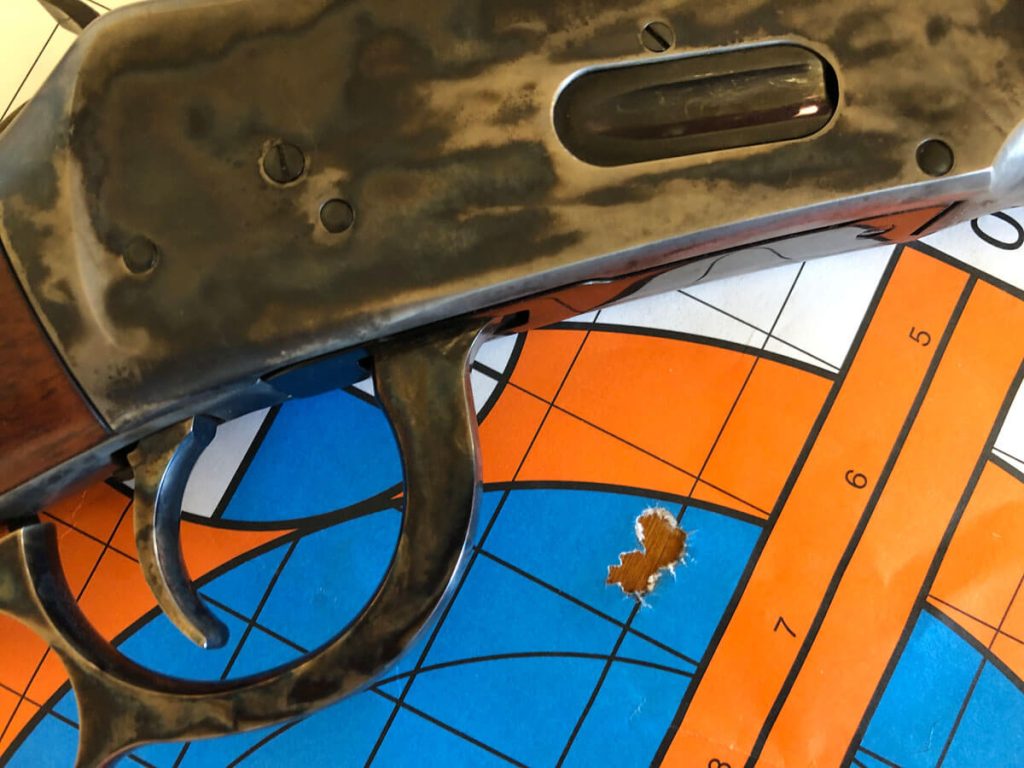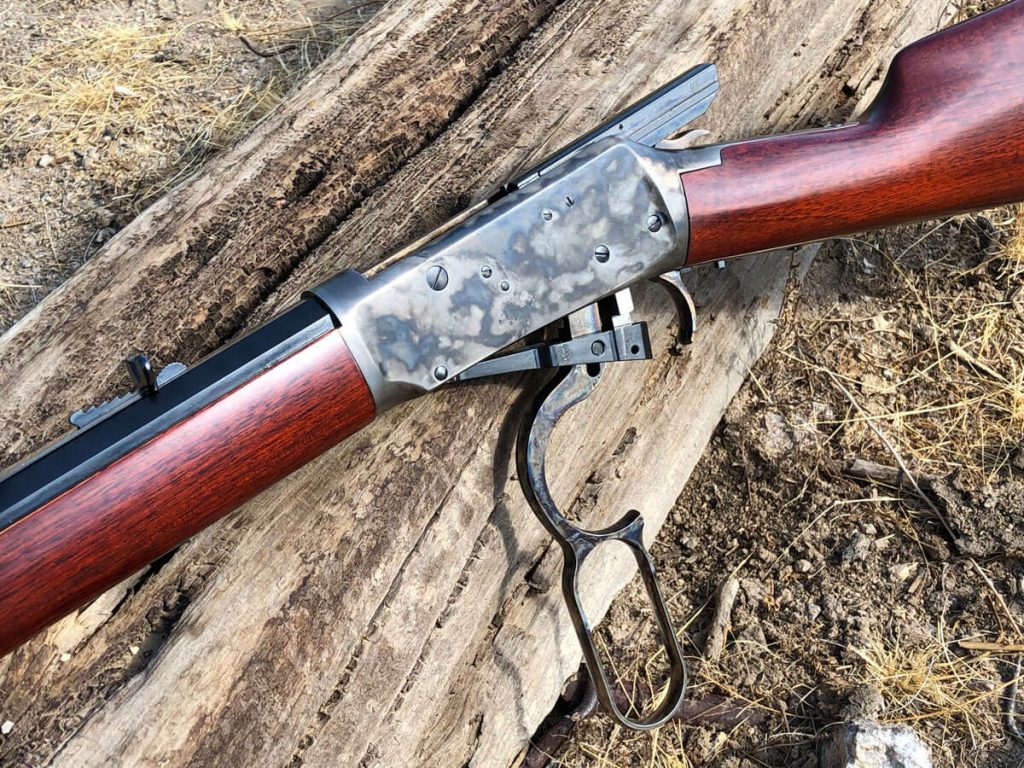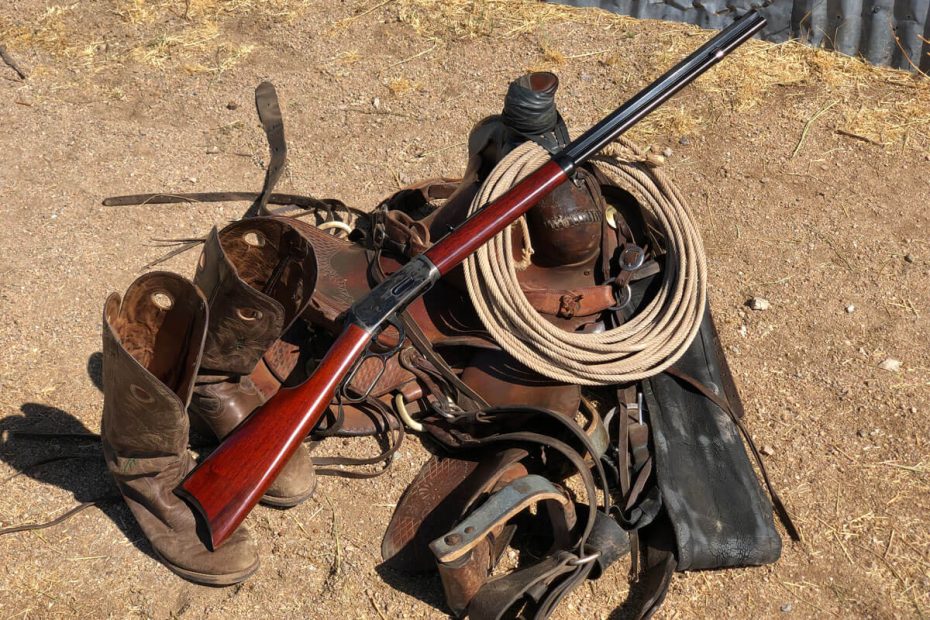
Blazing white in the evening light, a 10-inch steel gong offered a challenge I couldn’t resist. Throwing the color-casehardened lever on my long-barreled Winchester Model 1894 forward and back, I chambered a round and shouldered the rifle from a standing, offhand position. My sights wavered and then settled on the target, just over 100 yards distant. The trigger broke, the target clanged, and a charcoal-colored mark appeared in the exact center of the steel.
I was impressed.

HISTORY
The Winchester 1894 possesses a long and noble history and is considered by many historians to be the ultimate lever-action design. It also owns the distinction of selling more units than any other sporting rifle ever designed, at over seven million five hundred thousand rifles. Engineered by John Browning (arguably the greatest firearm designer the world has known) in 1894, this lever-action was first offered in .32-40 Win and .38-55 Win. In 1895 the Model 94 became the first rifle chambered for the smokeless-powder .30 WCF (Winchester Center Fire) cartridge. Later the .30 WCF name morphed into the .30-30 Winchester, though some rifles are still given the traditional .30 WCF label, including my test Cimarron Model 94 rifle.

Winchester 94s were built in the US by Winchester Repeating Arms Company until 1980. There was, however, a major snafu in 1964, when metallurgy and manufacturing processes were changed in an effort to make rifles easier and cheaper to produce. Winchester was successful in making the rifles cheaper, but not only in production. As a result, pre-64 rifles are prized by shooters and collectors and command significantly higher prices than post-64 rifles to this day. One major design improvement the company did make in 1982, though, was changing the top-eject system to angle-eject, enabling the mounting of standard riflescopes without interference between ejecting cartridges and optic. During the late ‘90s and early 2000s, Winchester added various and sundry safeties to the ‘94 rifles, to the disappointment of shooters who understand that a safety on a lever-action ‘94 makes as much sense as carrying a spare tire on an airplane.

CIMARRON EXCLUSIVE 26” 1894 RIFLE
Cimarron abandoned all the fluff and foofaraw created during the last half-century of Winchester ‘94 design “improvement” and offers rifles that are true to the legendary design and quality earned during the early days of 1894 lever-action glory. My test model is a Cimarron exclusive and features a 26-inch octagonal barrel, curvaceous crescent steel buttplate, and top-eject design. And no foolish safety. The wood gleams nicely with a traditional oil-type finish, and color casehardening adds beautiful color to the receiver, lever, hammer, and trigger. The buttplate, forend cap, magazine tube, and barrel are all a deep blue. Uberti of Italy, a well-known manufacturer of classic firearms, builds this exclusive for Cimarron.

Magazine capacity in my .30-30 test model 1894 is nine. Classic iron sights grace the long barrel. A crisp front post sight is nicely dovetailed into the top flat and features a setscrew mortised into the right side that locks the sight firmly into place in the dovetail. The rear sight is a traditional semi-buckhorn sight, also nicely dovetailed into the barrel. A square notch the perfect size for framing the front sight graces the inside of the buckhorn. The six-position ramp renders the sight adjustable for elevation and, like the front sight, there is a small set screw that locks the sight into position in its dovetail. Length of pull is 13 ¼ inches. Over-all weight is a mystery at this time because specs are not currently available on Cimarron’s website and my scale is exactly 485 miles away in Utah. Suffice it to say that the rifle feels solid and slightly heavy in the hand, but balances well and carries nicely.

FIT, FINISH, AND FUNCTION
As I mentioned above, I really like the finish on this Model 94, especially the color casehardening and the oil-type finish on the wood. The rifle looks and feels classic. The wood-to-metal fit is good, and the metal-to-metal fit is quite good. During testing, the rifle shoots rather well, as can be seen in the accuracy results in the chart below. I experienced zero malfunctions. The action is a bit tight when closing it on a cartridge, indicating close headspace tolerance. Cycling the action with ammunition on board is a bit rough, as is ejecting spent cartridges; but that’s not uncommon in a new rifle and I’m confident that the action will smooth out nicely with use.

The rifle handles and balances like a familiar old friend while carrying and shooting. It was surprisingly stable off the bench, and while shooting offhand as well. The trigger, however, is not great. While there isn’t any creep or grind (which is great) the trigger pull is rather heavy. Exactly how heavy I can’t say because, like my weight scale, my trigger gauge is 485 miles away. I would estimate it at around seven pounds. Not awful, but not something to inspire F-Class shooters to try a lever-action, either. However, heavy triggers and rough actions are historically common on lever-action rifles, and there is a good solution available, should you want one. You can hand your new rifle over to a good smith who is familiar with lever-action design and tuning, and have him perform an action and trigger job on it. When it comes back it’ll be silky-smooth and sport a great trigger. It’s money well spent and will make your lever-gun handle like a fast sports car.

As you’ll see in the accuracy test results below, the Model 1894 turned in some rather impressive groups. The groups all impacted about six inches above the point of aim at 50 yards with the sight ramp on its lowest setting. I personally would zero my rifle at 100 yards. Then I could use the rear sight ramp to adjust for longer-range shots.

CONCLUSION
Cimarron’s 26” octagonal-barreled exclusive is a really nice rifle. It’s very accurate, and suitable for hunting, horseback-carry, and a really good time at the range. As a side note, Cimarron also offers the rifle in .38-55 caliber; another historic round suitable for hunting, target shooting, and more.

Note: Testing was performed from a rested position at 50 yards, with a Shooting Chrony chronograph set 10 feet in front of the muzzle. Three, 5-shot groups were fired with each ammunition, the results added together and averaged.
| Manufacture | Bullet | Velocity (FPS) | Accuracy (Inches) at 50 yards | ES | SD |
| Hornady | 160 Gr. FTX | 2458 | 0.88 | 77 | 10 |
| Winchester | 150 Gr. Power Point | 2435 | 0.52 | 39 | 11 |
| Remington | 150 Gr. Core Lokt | 2473 | 0.81 | 67 | 23 |
